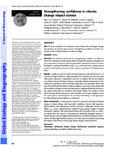Strengthening confidence in climate change impact science
| dc.contributor.author | O'Connor, MI | |
| dc.contributor.author | Holding, JM | |
| dc.contributor.author | Kappel, CV | |
| dc.contributor.author | Duarte, CM | |
| dc.contributor.author | Brander, K | |
| dc.contributor.author | Brown, CJ | |
| dc.contributor.author | Bruno, JF | |
| dc.contributor.author | Buckley, L | |
| dc.contributor.author | Burrows, MT | |
| dc.contributor.author | Halpern, BS | |
| dc.contributor.author | Kiessling, W | |
| dc.contributor.author | Moore, P | |
| dc.contributor.author | Pandolfi, JM | |
| dc.contributor.author | Parmesan, Camille | |
| dc.contributor.author | Poloczanska, ES | |
| dc.contributor.author | Schoeman, DS | |
| dc.contributor.author | Sydeman, WJ | |
| dc.contributor.author | Richardson, AJ | |
| dc.date.accessioned | 2017-10-29T18:53:24Z | |
| dc.date.available | 2017-10-29T18:53:24Z | |
| dc.date.issued | 2015-01 | |
| dc.identifier.issn | 1466-822X | |
| dc.identifier.issn | 1466-8238 | |
| dc.identifier.uri | http://hdl.handle.net/10026.1/10113 | |
| dc.description.abstract |
<jats:title>Abstract</jats:title><jats:sec><jats:title>Aim</jats:title><jats:p>To assess confidence in conclusions about climate‐driven biological change through time, and identify approaches for strengthening confidence scientific conclusions about ecological impacts of climate change.</jats:p></jats:sec><jats:sec><jats:title>Location</jats:title><jats:p>Global.</jats:p></jats:sec><jats:sec><jats:title>Methods</jats:title><jats:p>We outlined a framework for strengthening confidence in inferences drawn from biological climate impact studies through the systematic integration of prior expectations, long‐term data and quantitative statistical procedures. We then developed a numerical confidence index (<jats:styled-content style="fixed-case"><jats:italic>C</jats:italic><jats:sub>index</jats:sub></jats:styled-content>) and used it to evaluate current practices in 208 studies of marine climate impacts comprising 1735 biological time series.</jats:p></jats:sec><jats:sec><jats:title>Results</jats:title><jats:p>Confidence scores for inferred climate impacts varied widely from 1 to 16 (very low to high confidence). Approximately 35% of analyses were not associated with clearly stated prior expectations and 65% of analyses did not test putative non‐climate drivers of biological change. Among the highest‐scoring studies, 91% tested prior expectations, 86% formulated expectations for alternative drivers but only 63% statistically tested them. Higher confidence scores observed in studies that did not detect a change or tracked multiple species suggest publication bias favouring impact studies that are consistent with climate change. The number of time series showing climate impacts was a poor predictor of average confidence scores for a given group, reinforcing that vote‐counting methodology is not appropriate for determining overall confidence in inferences.</jats:p></jats:sec><jats:sec><jats:title>Main conclusions</jats:title><jats:p>Climate impacts research is expected to attribute biological change to climate change with measurable confidence. Studies with long‐term, high‐resolution data, appropriate statistics and tests of alternative drivers earn higher <jats:styled-content style="fixed-case"><jats:italic>C</jats:italic><jats:sub>index</jats:sub></jats:styled-content> scores, suggesting these should be given greater weight in impact assessments. Together with our proposed framework, the results of our <jats:styled-content style="fixed-case"><jats:italic>C</jats:italic><jats:sub>index</jats:sub></jats:styled-content> analysis indicate how the science of detecting and attributing biological impacts to climate change can be strengthened through the use of evidence‐based prior expectations and thorough statistical analyses, even when data are limited, maximizing the impact of the diverse and growing climate change ecology literature.</jats:p></jats:sec> | |
| dc.format.extent | 64-76 | |
| dc.language | en | |
| dc.language.iso | en | |
| dc.publisher | Wiley | |
| dc.subject | Abundance | |
| dc.subject | attribution | |
| dc.subject | climate change | |
| dc.subject | distribution | |
| dc.subject | hypothesis | |
| dc.subject | impacts | |
| dc.subject | marine | |
| dc.subject | phenology | |
| dc.subject | scientific method | |
| dc.subject | time series | |
| dc.title | Strengthening confidence in climate change impact science | |
| dc.type | journal-article | |
| dc.type | Journal Article | |
| plymouth.author-url | https://www.webofscience.com/api/gateway?GWVersion=2&SrcApp=PARTNER_APP&SrcAuth=LinksAMR&KeyUT=WOS:000345980300006&DestLinkType=FullRecord&DestApp=ALL_WOS&UsrCustomerID=11bb513d99f797142bcfeffcc58ea008 | |
| plymouth.issue | 1 | |
| plymouth.volume | 24 | |
| plymouth.publication-status | Published | |
| plymouth.journal | Global Ecology and Biogeography | |
| dc.identifier.doi | 10.1111/geb.12218 | |
| plymouth.organisational-group | /Plymouth | |
| plymouth.organisational-group | /Plymouth/Faculty of Science and Engineering | |
| plymouth.organisational-group | /Plymouth/REF 2021 Researchers by UoA | |
| plymouth.organisational-group | /Plymouth/REF 2021 Researchers by UoA/UoA07 Earth Systems and Environmental Sciences | |
| dc.identifier.eissn | 1466-8238 | |
| dc.rights.embargoperiod | Not known | |
| rioxxterms.versionofrecord | 10.1111/geb.12218 | |
| rioxxterms.licenseref.uri | http://www.rioxx.net/licenses/all-rights-reserved | |
| rioxxterms.type | Journal Article/Review |


